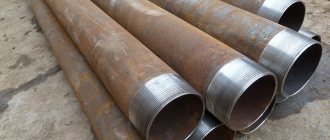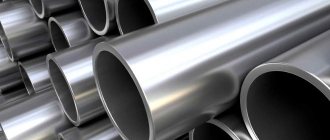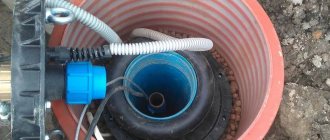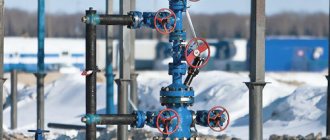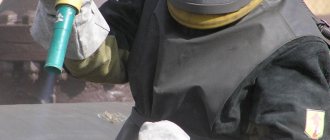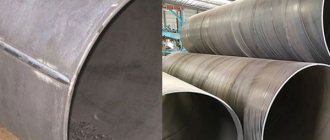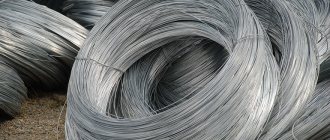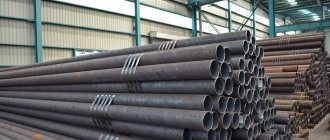Tubing is the basis of communications in the oil and gas industry. The functioning of the oil and gas industry, geological exploration and drilling of artesian wells is impossible without reliable specialized equipment. These products are used not only in the oil and gas industry, but also for supplying water from artesian wells and for transporting compressed air under pressure.
Tubing pipes are used in the oil and gas industry to transport aggressive media
Production
For the production of pump and compressor pipes, high-strength steel grades are used, which contain an increased amount of carbon. Steel 30ХМА is often used. The requirement is due to the need to protect the walls of pipelines from oxidation by chemically aggressive media and the extracted and distilled liquids and gases themselves.
The production of tubing pipes in Russia is regulated by GOST 633-80. The document defines several groups of these products:
- Tubing (standard) is a classic tube with a coupling connection. They ensure tightness of networks at internal pressure up to 50 MPa;
- NKT-V are pipes whose connecting threads are brought out (upset);
- NKB are pump-compressor tubes with external connecting threads, which are assembled into a pipeline without the use of a coupling;
- NKM – with a high-tightness coupling connection for particularly important areas and substances.
GOST determines the size, weight of the tubing pipe, necessary tests and other conditions of production, quality control and storage.
Basic requirements for standardization of tubing pipes
Tubing is the basis of communications in the oil and gas industry. They are highly reliable and durable. Connecting couplings and smooth workpieces are produced from durable steel grades D, E, K, L and M.
All requirements for the production of products are provided for by the standards of GOST 633-80, according to which specialized enterprises produce the following varieties:
- standard tubing pipes with couplings;
- highly hermetic NCM products;
- with NKT-V threads set outside;
- couplingless pipes NKB.
It is allowed to produce products according to specifications (technical conditions of the enterprise):
- with increased resistance to extremely low temperatures for operation in northern regions - TU 14-3-1282-84 and 14-3-1588-88.
- cold-resistant elements with increased resistance to damage (corrosion) from the supply of media with a high content of hydrogen sulfide and acid vapors - TU 14-161-150-94 and 14-161-173-97.
- products of increased plasticity, equipped with a connecting unit made of polymers - TU 14-3-1722-91.
Attention! At a short distance from the end of the product, where the coupling should be, there must be a marking in the form of a brand.
The stamp contains the following information:
- release date (year and month);
- wall thickness and cross-section (in mm);
- marking of steel by strength (letter designation);
- trademark of the manufacturing company.
One of the types of tubing pipes are products with increased corrosion resistance
Standard diameters of products in this segment range from 27 mm to 114 mm. The most popular products are 73 mm, 89 mm and 114 mm, and each group corresponds to the wall thickness and steel grade stated in the tables. For example, tubing pipe, dimensions:
- 27 mm – wall thickness 3 mm;
- 48 mm – 4 mm;
- 60 mm – 5 mm;
- 89 mm – 8 mm;
- 102 mm – 6.5 mm;
- 114 mm – 7 mm.
When placing an order with managers, it is important to indicate for what type of well these products are purchased - water, gas or oil, which will help make the best choice. When purchasing, be sure to ask the manufacturer or supplier for certificates for all products, including couplings, where the parameters provided must match the product labeling.
Characteristics
Basic requirements for tubing pipes:
- high resistance to aggressive environments that cause metal corrosion, as well as oxidation of transported media;
- resistance to low and high temperatures;
- plasticity is necessary for products to regulate the integrity of the line during heating/cooling and during internal pressure fluctuations. This parameter is ensured by the presence of plastic connections in different sections of the pipeline;
- absolute tightness;
- permeability of substances in the lumen of the pipe.
These qualities are regulated by various documents - GOST and individual specifications, which are available at each manufacturing enterprise.
The dimensions of the tubing pipe are specified in the assortment of the state standard:
- nominal diameter (external, rounded to the whole value) – 27...114 mm;
- length – 6...10 m (measured and unmeasured), can be adjusted according to customer needs.
Each product released from the conveyor has a mark from which you can find out all the defining characteristics: tubing pipe diameter, wall thickness, resistance value, grade or type of steel, name of the manufacturer.
Characteristics of tubing
Pipes for a pumping unit must be of high quality to cope with the functionality and high load. There is no damage, loss of integrity, delamination or cracks that could lead to their depressurization. There should be no ruptures or displacements inside the well itself in order to avoid major repairs of the well and equipment for as long as possible. These products can also be used to supply water from an autonomous well. Another application of the tubing pipe is the injection of air to clean the well using the blowing method.
Products of this class are subject to high quality requirements.
Since such parts often come into contact with an aggressive environment outside, there is high pressure inside, so they must be different:
- corrosion resistance;
- wear resistance;
- absolute tightness;
- excellent patency along the trunk (smooth).
The standard is within 6-10.5 m, at the customer’s request they can be 1 meter longer, that is, 11.5 m. Industrial production of tubing pipes is established in accordance with GOST, where the dimensions are specified and described in tables.
Products of this sample are produced in 2 types:
- with smooth ends;
- with external thread.
Tubing pipes treated at the connections have the greatest protection against depressurization and corrosion. The threads are additionally equipped with a special lubricant to ensure absolute tightness of installation. Visually, they differ in that the ends have coated external threads to connect the ends of two pipes with a special coupling.
Guaranteed tightness of communications under standard load - coupling pipe connection. The usual pressure in the system is within 50 MPa, and a special trapezoidal thread is used.
Areas of use
Tubing pipes are used both for their intended and non-direct purposes. Initially they are intended for the oil industry:
- completion of oil and gas wells;
- bitumen extraction wells;
- injection pipelines.
The specifics of the application determined the pipe tubing material, which is distinguished by high performance indicators. Over time, the products began to be used for other purposes:
- arrangement of water pipelines in private and multi-apartment construction;
- use as supporting structures for installing foundations, fences and other vertical structures.
Screw piles of different load-bearing capacities are made from tubing by welding blades to the pipe.
How is tubing repair carried out?
Tubing pipe with a special coating lasts longer. From time to time it requires cleaning in the form of chemical treatment or mechanical removal of deposits. They are aimed at removing asphaltenes, resins, and paraffins. In addition to these cleaning methods, magnetic, thermal and dewaxing methods are also used.
In some cases, cleaning itself is not enough and repair is required, which includes a wide range of steps to restore the operational characteristics of the material. Repair of pumping and well equipment can be carried out with pipes whose dimensions are 60, 73, 89, 102, 114 mm in diameter.
Their repair includes the following stages:
- Rejection of the product by visual inspection.
- Cleaning the product with water.
- Mechanical removal of contaminants from the inner surface of the product.
- Templating.
- Identification and elimination of product defects.
- Turning - includes re-threading, as well as repair and cleaning of the coupling.
- Coupling twist.
- Testing the system with water.
- Test of strength.
- Mandatory product labeling.
- Treatment of the coupling and nipple parts with a lubricant.
Tubing coupling pipe
To ensure that the repair of the material has a longer lasting effect, special spraying is used. Its surface is treated with a diffusion zinc coating, which demonstrates high adhesion to iron and a repellent effect to paraffins. This coating can extend the service life of the system by 3-5 times.
Specifications
According to GOST, product dimensions vary from 6 to 10.5 meters. If operational needs arise, the product can be extended up to 11.5 meters. The dimensions of their nominal outer diameter are 60; 73; 89; 114 mm. The dimensions of the wall thickness of the product can vary within 5.0; 5.5; 6.5; 7.0 mm.
Products are made from steel NKT 20, NKT 30 and steel NKT 30KhMA. During the production of products, any defects are excluded. Once detected, the product is sent for recycling. Its strength is characterized by groups D, K, E. During the manufacturing process, each unit of the product must be tested for tension, strength, hardness, cracking, impact strength and undergo hydrotesting.
Pipes 73 and 89 are produced with triangular or trapezoidal threads, and 60 and 114 mm - with triangular threads. The size of 89 millimeters corresponds to a wall thickness of 7.0 mm. The purpose of the 89 mm pipe is quite wide. It can be used not only in oil and gas production, but also in private housing construction for arranging pile foundations. Weight of a product with a diameter of 89 mm per 1 linear meter. is 13.5 kg.
Maintenance and repair of tubing pipes (video)
Operating rules
In order for pipes to serve for a long time, it is necessary to adhere to certain rules for their operation. Mechanized pipe carriers are used for loading and transportation. Transportation of products by drag is not allowed. They should not bend or sag. The material should be protected from mechanical damage. Therefore, unloading is carried out by crane.
At the work site, it should not be laid on bare ground, but on wooden blocks to avoid contamination or deformation. A safety ring must be placed on the threaded part.
Before operation, it is necessary to control the products by templates. To do this, a meter-long template with a diameter 2.3 mm narrower than its internal diameter is passed through the line. It is also worth cleaning the threads and coupling with a brush. Treat the surface of the parts with a special lubricant. Screwing the coupling from the thread is carried out carefully. In this case, you cannot use mechanical pressure or blows.
Basic rules for installation and operation
The coupling connection is useful for assembling pipes in oil wells - lines and columns can be disassembled, moved, and repaired if necessary. For installation, different types of couplings are used:
- straight,
- branching.
Using such systems, you can get a highway of any shape.
For pipes not equipped with a threaded element, the only possible installation method is welding. They are most often used in civil engineering.
There are several rules to remember when choosing tubing pipes as a piping system in a house or as a pile:
- unloading of products must be carried out on a flat, pre-prepared area;
- to prevent sagging and maintain the evenness of the pipe, it is laid on wooden blocks laid transversely under the entire length of the product;
- Carrying products by drag is prohibited;
- before starting installation, it is necessary to go over the threads with a wire brush to remove dirt and possible corrosion products, while leaving a protective lubricant - it will help to make a quality connection;
- In no case should pipes be subjected to mechanical shock, for example, compaction or installation into the design position using a sledgehammer - this will easily damage the integrity of the wall and reduce the quality of the pipeline.
These rules apply to the use of tubing in any industry - both in industry and in civil engineering.
How to properly operate tubing
When using tubing pipes, not only the requirements for their characteristics, but also the conditions for their transportation, storage and installation must be strictly observed. There are a number of generally accepted rules here.
- In the event that pipes need to be stored for some time before use, a special area should be prepared for this. Thus, pumping and compression pipes cannot be stored on the ground - they must be laid on wooden blocks and ensure that the products do not sag under their own weight.
Tubing storage
- To transport tubing pipes, you must use only specially designed transport (pipe trucks). Under no circumstances should tubing pipes be transported by dragging.
- In the event that it is necessary to unscrew a stubborn coupling from a tubing pipe, the threaded connection must not be subjected to shock loads. To do this, you can use special liquids or thoroughly clean the threaded connection from dirt.
- When transporting and storing pipes, their threaded ends should be protected using special safety rings.
Even when removing already used pipes from the well, they should be handled very carefully and stored on pre-laid wooden blocks.
What electrodes should be used to weld a tubing pipe?
To connect pipes without a threaded connection, only welding is used. In this case, you can only use arc welding with coated electrodes under submerged arcs or in shielding gases, which will ensure high strength of the seam.
The problem is that for the manufacture of pipes they use medium and high alloy steel, which has high strength, density and refractoriness. Specialists select electrodes based on the characteristics of the metal and the climatic conditions of the area during the period of work. For private practice, you can choose the classic SSSI 13/45 or 13/55, the seam holds optimally and is enough for a long period of operation. However, in this matter, much depends on both the power of the device and the skill of the welder himself.
- Engineering Communication
- Foundation
Application of tubing pipes-89 mm
Due to their low weight and size, such pipes are quite widely used in many modern oil, gas, and water production enterprises. Also, due to their excellent technical properties, they can be used in the construction of private houses and buildings.
However, the main use of 89 mm tubing pipes is transportation, injection of gas and liquid, as well as the organization of a pile foundation.
Considering that tubing-89 mm pipes are subjected to constant loads and exposure to aggressive substances, they must meet serious requirements and quality.
Therefore, the finished product must have the following qualities:
- Increased cross-country ability, both on straight and curved sections;
- Perfect tightness and insulation;
- Durability and wear resistance;
- Water resistance;
- Increased strength of materials and the pipe itself.
Installation
The algorithm for using tubing is as follows. They are inserted into the drilled well, after the casing (fixed) pipes are inserted and also fixed with cement. For this, as well as for securing, packers are used. Products are divided into types depending on what kind of fluid needs to be pumped out. They can be used for completing: oil, bitumen, or gas wells; they are used for injection wells. If it is necessary to produce in one well from different horizons, pipe strings are installed. When designing them, it is important to consider that they must be quickly and safely installed, and also reinstalled if necessary. Today, developers are striving to equip wells with products that can perform various functions without complete removal/replacement.
Manufacturing and heat treatment process
Functions
All tubing is considered according to certain parameters: • supply of optimal flow and its highest surface pressure; • does the product withstand the entire period of well operation for corrosion resistance; • susceptibility to erosion on this term; • indicators of how well the tubing can withstand the loads that stimulation work leads to; • how great is the strength under an action such as tension.
We recommend: Check valve for sewer pipes
GOST requirements
The tubing pipe is used to transport liquid and gaseous substances from wells to the surface. In technical terms, they are ordinary seamless pipes. According to GOST, they must have the following properties:
- High strength. During operation of the production platform, liquids and gases will flow through the pipeline under pressure. It is necessary that the pipeline installation retains its strength and does not crack. Even small leaks or cracks will lead to complete depressurization of the installation, which can lead to failure of the entire platform.
- Tensile resistance. Most modern wells are not completely straight. This is caused by various reasons: shortcomings in drilling, changes in the shape of the well due to the movement of the earth, and so on. It is important that the pipes retain their shape and do not crack when bent. In case of low tensile strength, the column may leak, which will lead to the destruction of the system.
- Density, tightness. The material from which the pipeline is made must be dense and airtight. This factor is especially critical for the ends of the installation that will be threaded. If the material is plastic, the thread will be of poor quality. Because of this, the tightness of the seams will be compromised, which can lead to depressurization of the system.
- Corrosion resistance. A large amount of liquid or steam will flow through the pipeline while the drilling rig is operating. This can cause rust to form, causing the pipe string to fail. For the manufacture of tubing, high-carbon steel is used, which contains chromium-based alloying additives. This component prevents the formation of rust and also stimulates the formation of a protective oxide film on the metal surface. Thanks to this, the installation does not crack or rust while the tower is in operation.
Production technology
Tubing pipes are made in several stages:
- Manufacturing of standard type pipes. After smelting the metal, a hollow semi-finished product is formed, which ends up in the pipe-rolling shop. Here, a full-fledged part is formed from a blank using the cold or hot rolling method. At the end, the part is hardened and cooled (if necessary). If the spare part will be stored in the workshop for some time, then intermediate marking will be applied to it in accordance with GOST rules.
- Preparatory work. Now the finished pipeline part enters the production workshop. Here the spare part is degreased and then cleaned. Grinding equipment is used for cleaning; manual processing is rarely used due to its low efficiency.
- Threading on one end. After treatment, control ultrasonic flaw detection is performed. If everything is fine with the spare part, a thread is applied to one of its edges using special tools. Immediately after applying the thread, repeated flaw detection is carried out, which makes it possible to determine the quality of the thread. If all is well, a tubing coupling is mounted on the end of the part. Then the installation is cleaned with water.
- Threading the second end. Now the worker uses tools to apply threads to the other end of the part. Then he performs control flaw detection, and the check is performed twice, since a protective coupling will not be mounted on this end. If everything is fine with the spare part, a protective casing-protector is screwed onto the thread.
At the end, final processing, packaging, and transportation are performed. Upon completion of all work, the finished spare part is washed and checked for defects, damage, and scratches. Control weighing is also carried out and GOST markings are applied. If all is well, the spare part undergoes a preservation procedure. Finally, it is packed into metal, plastic or wooden blocks for storage in a warehouse.
Operation
There are a number of rules that must be followed when operating tubing. 1. They should not be dropped to the ground during loading and unloading. You need to use a crane. 2. Pipe trucks are an essential element of their transportation. Dragging or bending in such a way that they sag or bend is prohibited. 3. Before laying the pipes on the site, you need to place wooden blocks under them. Safety rings for pipes must be screwed on if they are placed on threaded parts. 4. Before lifting via bridges, it is necessary to determine the condition of the product. To do this, a template is passed through it, having a diameter several millimeters less (two or three) than the internal diameter of the part. The length of the template is 5-10 cm. Before it comes out, the lower end of the product is held. 5. It is imperative to go over the threads of the coupling and nipple with a metal brush before starting screwing, and treat the threads with lubricant. 6. It is unacceptable to hit the coupling with a sledgehammer.
Dimensions, weights and tolerances of unset tubing couplings
Operating principle of drilling rigs
To understand the purpose of tubing, you need to know the principle of operation of drilling rigs. Drilling rigs are used to extract water, gas and oil, which are located deep underground. They differ from each other in many parameters - operating principle, design, performance characteristics and others. Typically, a drilling rig consists of three elements - an aboveground platform, a drill string and a power system. The installation may also include additional elements - a controlling pneumatic drive, a drill cooling system, warning sensors, and so on.
Drilling technology
- At the preparatory stage, geologists conduct exploration and outline the proposed drilling location. Then the drilling platform is mounted and a test run of the installation is performed. During the test, the following parameters are checked: the quality of the joints of parts with each other, the level of vibration, and the level of load on the electric motor.
- If everything is fine with the platform, a well is drilled. For drilling, a drill string is used, which is connected to an electric motor. At the end of the column there is a sharp tip-chisel, which destroys hard rocks.
- During operation, the drill string rotates along its axis, which leads to the formation of a well. At the same time, the waste soil is supplied to the surface. Modern rigs are equipped with a system for supplying protective chemicals, which minimizes the risk of damage to the drill string.
- After creating a well, it is necessary to fix it. To solve this problem, two technologies can be used. In the first case, an additional pipe is installed in the well, which creates a gap between the column and the pipe itself. Soft mixtures are poured into this gap and quickly harden. In practice, this method is rarely used. In the second case, a casing pipeline is installed in the well, which has thick walls and can withstand any load.
- After strengthening the well, pipes are inserted into the casing to pump out minerals or water. Tubing can be used as such a pipe. Before they are introduced into the well, they are secured using well couplings, which turn the individual tubing pipes into a single compression string. To extract minerals, an electric motor is started, which pumps oil or gas from the well to the surface. On the drilling platform, minerals are packed into containers (barrels, tanks, vats).
Please note that tubing can be used in other scenarios. A simple example: a pipeline can be configured not to suck in liquids, but to spray them. This technology allows for the injection of liquids, which can be useful in some areas of human activity. Examples - well repair, geological exploration, local increase in pressure, creation of additional inflows to the main well.
